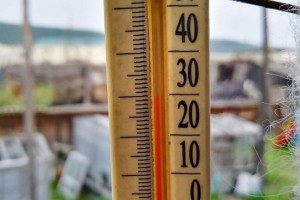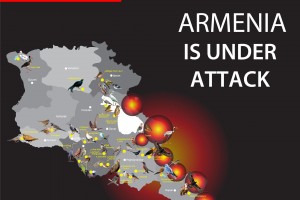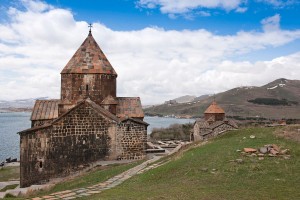More Crops Per Drop: Conserving Armenia’s Water Resources Amidst a Changing Climate

Armenia faces severe water challenges due to climate change and needs immediate and long-term strategies to safeguard its water resources and ensure sustainable agriculture. A four-pronged approach is needed.
Armenia is highly vulnerable to climate change. Temperatures increased 1.230C between 1929 to 2016, faster than the global average. From 1935 to 2016, precipitation fell by almost 9%.
Water resources are vital with about 80% of the country’s crops requiring irrigation, and hydropower accounting for 23-25% of total energy production. Future projections are grim. River flows are estimated to decrease by more than 13% by 2040 and by 27% by 2070. Average annual evaporation of Lake Sevan, the country’s largest freshwater body and a vital source of irrigation water, is expected to increase by 30% over this century.
These impacts will affect many aspects of Armenian life but especially agriculture. Soil moisture levels are forecasted to decrease by 30% over the next 100 years; land productivity could decrease by 24%.
These trends will harm rural livelihoods, especially of farmers reliant on increasingly scarce water resources, place greater pressure on national food security and potentially exacerbate competing demands for water across different water users, like water for cities and for energy.
The Armenian government recognizing its vulnerability to climate impacts has prioritized water resources management. Scarce water resources must be used more productively. This means growing more crops with the same amount of water or ensuring water storage for irrigation when needed.
A four-pronged approach should be adopted for this purpose:
1. Thinking ahead from a climate lens. More detailed climate change risk assessments at the regional or even district can identify the hot spots, or areas with the highest risk to water scarcity. A risk-based approach can prioritize water resource infrastructure like dams and irrigation systems for modernization, and identify the most vulnerable communities. Supporting these communities with alternate livelihoods, water conservation techniques and improved technologies to use less water but grow the same amount of crops is key to rural prosperity within a changing climate. This analysis, supported by better monitoring data on water availability and usage, should inform a comprehensive strategy on water investment.
2. Increasing water storage – Kaps Reservoir is a quick win. One of the ways to manage increased climate variability, and avoid too much or too little water at crucial times in the crop-growing season or for power generation, is to increase water storage. The country has 81 reservoirs which could be improved for increased storage and more reliable irrigation water supply downstream. A prime example is expansion of the Kaps Reservoir. Armenia has recognized the importance of this project for decades. Its first phase is now being constructed at an estimated cost of €74 million. However, with an additional investment of €25 – €40 million, Armenia can expand the reservoir from 25 million to 60 million cubic meters. Plus, if the first and second phases are constructed concurrently, the government will save an estimated €6 million over doing the projects separately; a decision to proceed with the second stage is needed now to capture these savings.
3. Modernizing existing irrigation infrastructure. An estimated 70% of the water in Armenia’s reservoirs is lost by the time it reaches farmers’ fields. This is more than double the European average. These losses are largely due to antiquated infrastructure that dates to the Soviet era. Refurbishing these assets is a cost-effective approach that minimizes environmental and social impacts.
4. Strengthening water governance. Water in Armenia cuts across governmental agencies. The Water Committee is responsible for water infrastructure, the Ministry of Environment for water resources, the Ministry of Finance for budgeting new investments, etc. This diverse range of interests can weaken decision making. Alternative structures include vesting one ministry with overall authority or devolving irrigation system operation and management to user groups. Decisive leadership could not only expedite decisions regarding the overall strategy, including expansion and refurbishment of the Kaps Reservoir, but also effectively coordinate water sector donors.
While a comprehensive water resources strategy is ideal, it shouldn't delay urgent climate-related investments. Commonsense investments that benefit water users now and, in the future, should be prioritized.
Don Lambert – Country Director, ADB Armenia Resident Mission
Yasmin Siddiqi - Agriculture, Food, Nature, and Rural Development, ADB Sectors Group Director
Suggestions
 At the World Conference on Programming of the Green Climate Fund, the Deputy Minister of Environment touched upon the large-scale aggression of Azerbaijan against the territory of the Republic of Armenia
At the World Conference on Programming of the Green Climate Fund, the Deputy Minister of Environment touched upon the large-scale aggression of Azerbaijan against the territory of the Republic of Armenia
 The Ministry of Environment sent a letter international partners to draw their attention to the real danger of environmental disasters as a result of Azerbaijan's large-scale aggression towards the territory of Armenia
The Ministry of Environment sent a letter international partners to draw their attention to the real danger of environmental disasters as a result of Azerbaijan's large-scale aggression towards the territory of Armenia
 What is the temperature?
What is the temperature?
 We stand for peace!
We stand for peace!
 Hydrological regime of Lake Sevan on August 22-28 (2022)
Hydrological regime of Lake Sevan on August 22-28 (2022)












